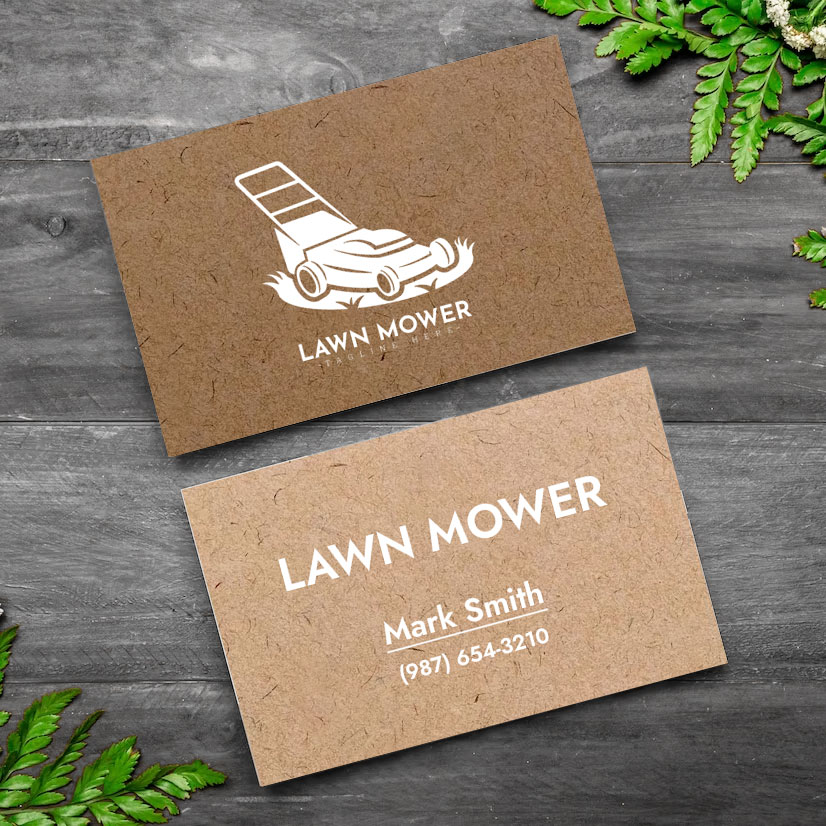Eco-friendly materials or inks for your landscaping business cards, an idea as refreshing as a newly watered garden! But does it hold water when it comes to practicality? Let’s dig deeper, and green thumbs up for environmental responsibility!
Eco-Friendly Materials
Pros:
- Brand Alignment: As a landscaping business, an eco-friendly card aligns perfectly with your brand’s nature-loving ethos. It’s like choosing native plants for a local garden – an intuitive match!
- Stand Out: Eco-friendly cards can help you stand out from the crowd, reflecting your company’s commitment to sustainability. It’s like having an exotic plant in your garden, eye-catching and conversation-starting!
Cons:
- Cost: Eco-friendly materials can be more expensive. Like opting for rare, imported plants, you’ve got to balance the aesthetic and the budget.
- Availability: Not all printers offer eco-friendly options, so you might have to search a bit for a suitable provider.
Eco-Friendly Inks
Pros:
- Environmental Responsibility: Eco-friendly inks reduce harmful impact on the environment, demonstrating your commitment to ‘green’ practices. It’s like using organic fertilizers – good for the earth, and good for the soul!
- Health Friendly: These inks are typically lower in volatile organic compounds (VOCs), safer for you, your clients, and the printer’s staff.
Cons:
- Cost: Eco-friendly inks can be more expensive.
- Color Vibrancy: Some eco-friendly inks might not be as vibrant as standard inks, although this has improved greatly with advancements in technology.
Using eco-friendly materials and inks for your landscaping business cards is a brilliant way to underscore your commitment to the environment, enhancing your brand’s image. But like choosing between a dazzling floral display or a subtle, water-saving xeriscape, the decision will hinge on your budget, your brand ethos, and the impression you want to make on your clients.
Is printing on both sides of the card eco-conscious?
Printing on both sides of a business card can be considered eco-conscious, as it maximizes the use of the card’s surface area and reduces waste. By utilizing both sides, you are minimizing the amount of material needed for printing, which can be more sustainable in terms of resource consumption and reducing environmental impact. Also, business wise, just using it for contact information can be considered a lost opportunity.
However, it’s important to consider other factors in the printing process that can contribute to the overall eco-friendliness of the business cards. Here are a few additional considerations:
- Paper selection: Choose environmentally friendly paper options, such as recycled or sustainably sourced paper. Look for certifications like FSC (Forest Stewardship Council) or use paper made from alternative fibers like bamboo or hemp.
- Soy-based inks: Opt for soy-based or vegetable-based inks instead of petroleum-based inks, as they are more environmentally friendly and have lower VOC (Volatile Organic Compounds) emissions.
- Coatings and finishes: Minimize or avoid the use of coatings and finishes that contain harmful chemicals or are not easily recyclable. If coatings are necessary, consider water-based or environmentally friendly options.
- Quantity control: Print only the number of business cards you need to reduce excess waste and unnecessary printing.
- Recycling: Encourage recipients to recycle the business cards once they are no longer needed, and use the appropriate recycling methods for the type of paper and ink used.
Remember, the overall eco-consciousness of business cards goes beyond just printing on both sides. It involves considering the entire lifecycle of the cards, including the materials used, printing practices, and responsible disposal or recycling. If you really want to be super eco-conscious, maybe don’t print at all and do it solely online with directories for advertising your landscaping service?
